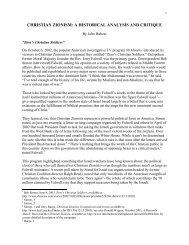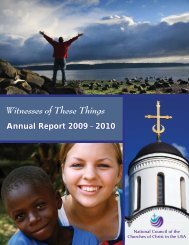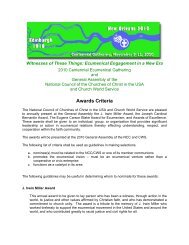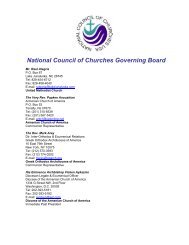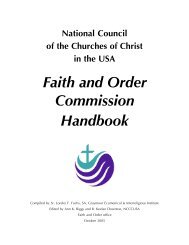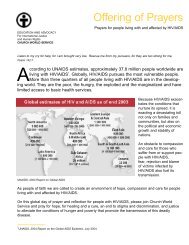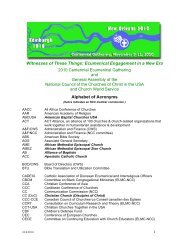Common Agreement on Mutual Recognition of Baptism - National ...
Common Agreement on Mutual Recognition of Baptism - National ...
Common Agreement on Mutual Recognition of Baptism - National ...
You also want an ePaper? Increase the reach of your titles
YUMPU automatically turns print PDFs into web optimized ePapers that Google loves.
632<br />
633<br />
634<br />
635<br />
636<br />
637<br />
638<br />
639<br />
640<br />
641<br />
642<br />
643<br />
644<br />
645<br />
646<br />
647<br />
648<br />
649<br />
650<br />
651<br />
652<br />
653<br />
654<br />
655<br />
656<br />
657<br />
658<br />
659<br />
660<br />
661<br />
662<br />
663<br />
664<br />
665<br />
666<br />
667<br />
668<br />
669<br />
670<br />
671<br />
672<br />
673<br />
674<br />
675<br />
676<br />
were given ―under the Law‖ (Scots C<strong>on</strong>fessi<strong>on</strong> XXI) from those given under the new<br />
dispensati<strong>on</strong>. The Sec<strong>on</strong>d Helvetic C<strong>on</strong>fessi<strong>on</strong> asserts that ―a great difference‖ exists between<br />
the signs. The new signs are ―are more firm and lasting,‖ ―more simple and less laborious,‖ and<br />
―bel<strong>on</strong>g to a more numerous people.‖ Further, ―both the substance and promise‖ (et rem et<br />
promissi<strong>on</strong>em) have been ―fulfilled or perfected‖ in Christ, and ―a greater abundance <strong>of</strong> the<br />
Spirit‖ follows (XIX).<br />
3. c. Summary<br />
In our respective accounts <strong>of</strong> sacramentality it is evident that this theological c<strong>on</strong>cept<br />
weighs more heavily in the Catholic than in the Reformed traditi<strong>on</strong>. Perhaps this is most clear in<br />
our respective understandings <strong>of</strong> ecclesiology. As we have seen in the Catholic secti<strong>on</strong>, the<br />
noti<strong>on</strong> <strong>of</strong> the Church as sacrament emerged in theology, in the c<strong>on</strong>ciliar documents <strong>of</strong> the Sec<strong>on</strong>d<br />
Vatican Council, and has been utilized in the Catechism <strong>of</strong> the Catholic Church. Reformed<br />
theologians have been less apt to appropriate this ecclesiological model. It is interesting that the<br />
following statement appeared in the 1976 Report <strong>of</strong> the U.S. Presbyterian & Reformed-Roman<br />
Catholic Dialogue, entitled The Unity We Seek.<br />
…we see the Church as called to be a sign—a sacrament—<br />
<strong>of</strong> that unity which God has willed for his creati<strong>on</strong> and<br />
disclosed in Jesus Christ.<br />
However at the internati<strong>on</strong>al level things are quite different.<br />
In the sec<strong>on</strong>d phase (1984-1990) <strong>of</strong> the Dialogue between the Roman Catholic Church<br />
and the World Alliance <strong>of</strong> Reformed Churches, the Final Report entitled Towards a <str<strong>on</strong>g>Comm<strong>on</strong></str<strong>on</strong>g><br />
Understanding <strong>of</strong> the Church, two respective c<strong>on</strong>cepti<strong>on</strong>s <strong>of</strong> the Church were examined: the<br />
Church as ―Creatura Verbi‖ for the Reformed traditi<strong>on</strong> and the Church as ―Sacrament <strong>of</strong> Grace‖<br />
for Roman Catholics. In their ―Questi<strong>on</strong>s and Reflecti<strong>on</strong>s‖ <strong>on</strong> these distinct ecclesiologies the<br />
document states what is worth quoting in full.<br />
112. We are agreed in recognizing the radical dependence<br />
<strong>of</strong> the church in receiving the transcendent gift which God<br />
makes to it, and we recognize that gift as the basis <strong>of</strong> its<br />
activity <strong>of</strong> service for the salvati<strong>on</strong> <strong>of</strong> humanity. But we do<br />
not yet understand the nature <strong>of</strong> this salutary activity in the<br />
same way. The Reformed comm<strong>on</strong>ly allege that Catholics<br />
appropriate to the church the role proper to Christ. Roman<br />
Catholics, for their part, comm<strong>on</strong>ly accused the Reformed<br />
<strong>of</strong> holding the church apart from the work <strong>of</strong> salvati<strong>on</strong> and<br />
<strong>of</strong> giving up the assurance that Christ is truly present and<br />
acting in his church. Both these views are caricatures, but<br />
they can help to focus attenti<strong>on</strong> <strong>on</strong> genuine underlying<br />
differences <strong>of</strong> perspective, <strong>of</strong> which the themes <strong>of</strong> creatura<br />
verbi and sacramentum gratiae serve as symbols.<br />
16



